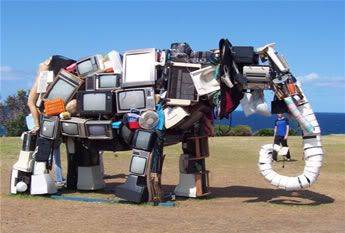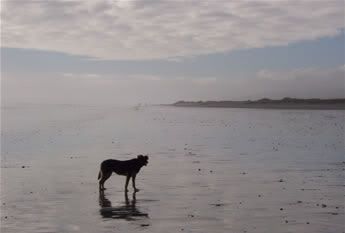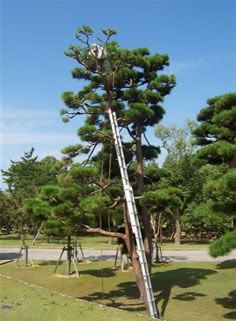
The sun slipping below the buildings of the Rocks on Sydney harbour. This was part of my walk home from work in Milson's Point - out of the office and over the Harbour Bridge, along to Macquarie Street, through Hyde Park and up Oxford Street. There can be few greater commutes in the world, I think. This is the Cahill Expressway, which was bulldozed through Circular Quay and although it gives you a great view of the bridge and harbour (just off to the right) it's an utter eyesore.

I was in Sydney for over three months until I got a job, just living on what I'd scraped together and taken with me after doing months of overtime and 7:30am-6:00pm Sundays. Days out like this were my reward. I remember walking into the office thinking I was getting the finances purely so I could do things like sitting all day at a cricket match drinking beer, and it kept me going. This was taken at a rather dull midweek affair between NSW and the touring New Zealanders - as you can see the Sydney Cricket Ground was deserted. I didn't care though, I sat there for seven hours and it was bloody great.

Every year Sydney hosts an outdoor exhibition of modern sculpture called 'Sculpture by the Sea' - it takes place on the coastal footpath that runs from Bondi to Tamarama. On a typically lovely weekend day, I wandered around looking at the wierd and wonderful entrants trying to figure out whether I liked any of them. This elephant was one I did like - if only for the amazing amount of work that must have gone into it, and the details which you could see up close. Computer monitors make great feet - and the mouth is an old toilet.

Ahhh, WA. Now there's a relaxed state. I took four days to travel Northwards up the coast from the capital Perth to the small naval tracking station of Exmouth. On the way, we frequently stopped at places like this - Shell Beach. I was just about to take a picture of some of the guys from the bus wading into knee-deep water to find somewhere to swim, when one of the girls ran to the front and took a photo of us looking at them. The bay was so shallow (and salty) that they walked for ten minutes and the water was still only halfway between their knees and their waists - so they gave up and sloshed back to the beach.

This is the small town of Akaroa in New Zealand, just outside Christchurch on the South Island. In the European rush for the New World, the South Island was initially claimed by the French. Based at the natural harbour of Akaroa, they made a claim for the entire group of islands. The trouble was, the native Maori had signed a deal with the British to 'sell' them their land (under pressure, no doubt), so the British then dutifully evicted the French from the country and proceeded to suppress the Maori and generally take over. To placate the French slightly, the Brits let them keep Akaroa - so even today the street names are in French, and the tricolore flutters in the streets. It's part of modern New Zealand of course, but the French background keeps the tourists flocking in...

On the other coastline of the South Island are miles and miles of deserted beaches. I got a bus from Christchurch to Barrytown, and was supposed to get off at the Barrytown Inn to meet my Stray bus for the start of my tour. I asked the driver to point out the Inn when we got to Barrytown, as I didn't have a map and it wasn't in the guidebook. He started laughing, and when we got to Barrytown I got off and realised why - there are only five buildings in the town. The driver (who had a big smile on his face) pointed to the only building that wasn't a shack, and drove off. I spent four hours walking on this beach, and only saw two women on horses and this dog, that followed me around for about an hour before getting bored and wandering off.

We got some incredible rain on the circuit of the South Island - none more so than at Milford, where we got battered by heavy rain and gale-force winds. We got out in a rainstorm to look at a gorge on the River Cleddau near the fjord of Milford Sound. Signs at the start of the path had called it a 'Chasm Walk', so we were expecting something pretty good. When we got there, this was it - the guy next to me looked down and said 'This isn't a chasm, it's just a f*cking hole' - but I pointed my camera over the edge of the bridge and took a picture anyway.

One of my favourite places in New Zealand was the 'third island' - Stewart Island. Only a small one, it lies just South of the coast of the South Island - it's pretty remote, and most Kiwis haven't been there. It's a fishing and oyster farming island, with amazing natural bird life, and not much else. We stayed overnight there, and took a tiny bouncing boat to the bird sanctuary of Ulva Island where amazingly rare birds walked, hopped and flew around without any predators to worry about. At night we went to the only pub on the island and drank with some of the fishermen. This was taken at dawn the next morning, waiting for the ferry to be loaded so we could brave the rough Foveaux Straight crossing back to the mainland of the South Island.

The Japanese have a love of nature - but a very ordered kind of nature, on their terms. This is one of the reasons why bonsai is so popular, and this is a picture of the other extreme. The large park in Nara, just East of Kyoto, has hundreds (probably thousands) of trees - and all of the pine trees are carefully clipped and pruned to accentuate their shape. Gardeners have been doing this in Nara for centuries - it was the original capital of Japan. Apparently the men that do this are experts, and there are very few of them, as it is a difficult skill to master. They don't just wade in with the strimmer - this man was delicately balanced up a massive tree carefully snipping away, looking as if he could tumble out at any moment.

Seafood is king in Japan - at Tsukiji fish market in Tokyo they sell an astonishing £15m worth per day. This picture is something you see quite often in smaller Japanese towns if they are by the sea - dried seafood for sale. In this case an octopus, but also all kinds of fish and squid were laid out on benches or hung on specially designed coathangers and fluttering in the breeze. At first, I thought it was a kite - but people do eat it, although I'm not sure how. I didn't try octopus jerky, although I did eat it raw, and it was lovely. The other thing I thought when I saw this was 'How did they flatten it?'

What do you think this is? It doesn't look like a ferris wheel, but that's what it is. In the Ebisubashi entertainment district of Osaka, it's a 'couples' ferris wheel, with enclosed bubble-like capsules that slowly revolve to give a panorama of the city. This part of Osaka was like something out of Bladerunner (although it wasn't raining) - the amount of neon and huge illuminated signs and billboards was staggering. You really feel like you're in a high-tec modern city when it dazzles you like this. I'm not sure why the front of the ferris wheel has a large man hugging a worried-looking penguin wearing a santa hat on it, but I'm sure there's an explanation.

The best view of the holiday - one of the three 'Best Views of Japan' in fact, as decided by the Japanese themselves. This is the o-torii gate of Itsukushima on the island of Miyajima, just off the coast of Hiroshima. We stayed there for two days, and saw this wonderful gate in all conditions - day/night, sun/cloud, high/low tide. Designed as an approach to a floating temple in 597AD, it's 16m high and lit up at night by the spotlight on the right. The temple and shoreline were really busy during the day, but deserted at night. I sat on a stone bench with a can of Kirin I got from a vending machine - something that would be inconceivable in the UK, and took this photo.